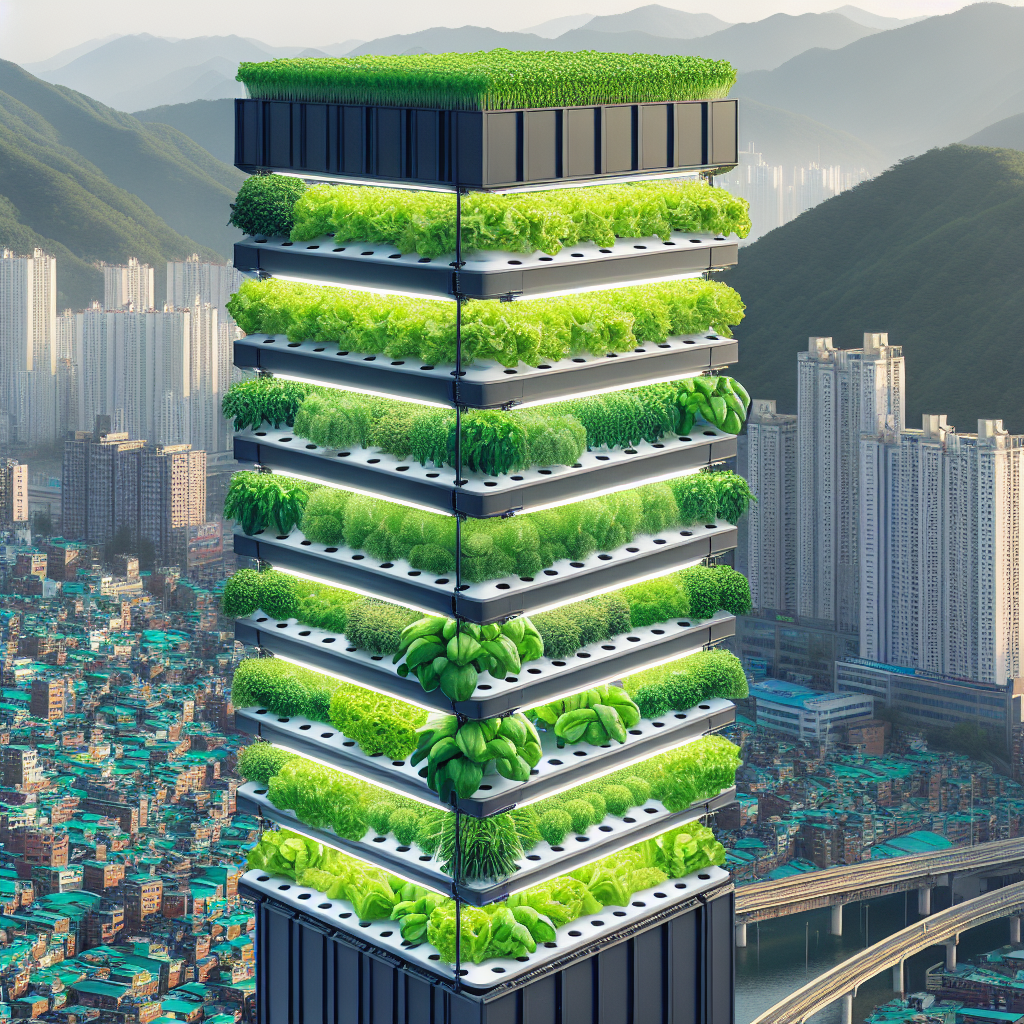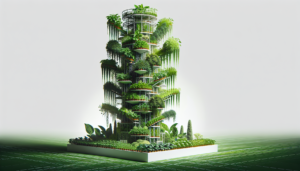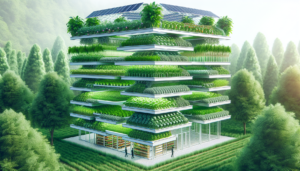
Imagine a world where fresh, nutritious produce is grown year-round, regardless of the weather or location. Enter vertical farming – a revolutionary solution that is transforming the future of agriculture in Korea. By harnessing the power of technology and innovation, vertical farming allows crops to be cultivated in vertically stacked layers, maximizing land efficiency and minimizing environmental impact. Explore how this cutting-edge practice is revolutionizing the way we grow our food, ensuring a sustainable and bountiful future for generations to come.
Heading 1: Introduction to Vertical Farming
Vertical farming is a revolutionary agricultural technique that is gaining popularity worldwide, including in Korea. This innovative farming method involves the cultivation of plants in vertically stacked layers, allowing for the efficient use of limited space in urban areas. By utilizing advanced technology and controlled environments, vertical farming offers numerous advantages over traditional farming practices. In this article, we will explore the definition and concept of vertical farming, discuss its importance in agriculture, and explore the growth and potential of vertical farming in Korea.
Subheading 1.1: Definition and concept of vertical farming
Vertical farming refers to the practice of growing crops in vertically stacked layers, often in enclosed environments such as urban buildings or greenhouses. This technique utilizes different hydroponic or aeroponic systems, which provide plants with the necessary nutrients and water through a soil-less medium. Artificial lighting systems, such as LED lights, are used to provide the necessary light for photosynthesis. By growing crops vertically, this method maximizes the use of available space, making it ideal for urban areas where land is limited.
Subheading 1.2: Importance of vertical farming in agriculture
Vertical farming plays a crucial role in addressing some of the major challenges faced by traditional agriculture. One of the key advantages of vertical farming is its resource efficiency. By using hydroponic or aeroponic systems, vertical farms consume significantly less water compared to traditional farming methods. Additionally, the controlled environment allows for the precise use of nutrients, reducing the need for excessive fertilizer application. These resource-efficient practices help conserve water and minimize environmental impacts.
Subheading 1.3: Growth and potential of vertical farming in Korea
Korea has witnessed significant growth in the vertical farming industry in recent years. With limited arable land and an increasing urban population, vertical farming offers a promising solution to meet the demand for fresh produce in urban areas. The Korean government has recognized the potential of vertical farming and has been actively promoting its development through various initiatives and support programs. As a result, the industry is experiencing rapid growth, with numerous vertical farming companies emerging and expanding their operations across the country.
Heading 2: Advantages of Vertical Farming
Vertical farming offers several advantages over traditional farming methods. Let’s explore some of the key benefits this agricultural technique provides.
Subheading 2.1: Resource efficiency in vertical farming
Resource efficiency is one of the primary advantages of vertical farming. By using hydroponic or aeroponic systems, vertical farms can significantly reduce water consumption compared to traditional soil-based farming. In a hydroponic system, plants are grown in nutrient-rich water, and this water is recycled and reused, leading to a substantial reduction in water usage. Furthermore, vertical farms can optimize the use of fertilizers and other inputs, minimizing waste and environmental pollution.
Subheading 2.2: Year-round crop production
Vertical farming enables year-round crop production irrespective of seasonal restrictions. By controlling the environmental factors such as temperature, humidity, and lighting, crops can be grown consistently throughout the year. This ensures a steady supply of fresh produce, reducing the reliance on imported goods and enhancing food security.
Subheading 2.3: Decreased reliance on traditional farming practices
Traditional farming practices are often limited by the availability of arable land, weather conditions, and the use of pesticides. Vertical farming alleviates these issues by providing a controlled environment that is free from external factors. By growing crops indoors, vertical farmers can protect their plants from extreme weather events, pests, and diseases, reducing the need for chemical pesticides or genetically modified organisms.
Heading 3: Technology and Innovation in Vertical Farming
The success of vertical farming heavily relies on technological advancements and innovations. Here, we will delve into some of the key technologies and innovations driving the vertical farming industry.
Subheading 3.1: Automated systems and robotics
Automation plays a vital role in vertical farming, optimizing efficiency and reducing labor costs. Automated systems can monitor and control various aspects of the farming process, including nutrient delivery, lighting, and climate control. Robotics, such as robotic arms, can assist with tasks like planting, harvesting, and maintenance. These technological advancements help streamline operations and ensure consistent plant growth and productivity.
Subheading 3.2: Artificial lighting and controlled environment
Artificial lighting is an essential component of vertical farming, as it enables plants to photosynthesize and grow even in the absence of natural sunlight. LED lights are commonly used in vertical farms due to their energy efficiency and ability to provide specific light spectrums required for plant growth. Additionally, the controlled environment within vertical farms allows for optimal temperature, humidity, and CO2 levels, ensuring plants receive the ideal conditions for growth.
Subheading 3.3: Sensors and data analytics
Sensors and data analytics play a crucial role in monitoring and managing vertical farms. Sensors can measure various parameters such as temperature, humidity, pH levels, and nutrient concentrations in real-time. This data is then analyzed to optimize growing conditions, detect anomalies, and predict crop yields. By harnessing the power of data analytics, vertical farmers can make data-driven decisions and continuously improve their farming practices.
Heading 4: Vertical Farming Techniques in Korea
Korea has been at the forefront of developing and implementing various vertical farming techniques. Here, we will discuss some of the most commonly used techniques in vertical farming in Korea.
Subheading 4.1: Hydroponics in vertical farming
Hydroponics is a popular technique used in vertical farming, particularly in Korea. This method involves growing plants in nutrient-rich water without the use of soil. Instead, plants are supported through inert mediums like perlite or coconut coir, which retain moisture and provide support. Hydroponics allows for precise control over nutrient delivery, maximizing plant growth and minimizing resource consumption.
Subheading 4.2: Aeroponics in vertical farming
Aeroponics is another technique widely adopted in Korean vertical farms. It involves suspending plant roots in a mist or fog environment, providing them with nutrients and water through a fine mist. This method promotes rapid plant growth and efficient nutrient uptake while using minimal water compared to traditional farming. Aeroponics is particularly suitable for growing leafy greens and herbs, making it a popular choice among urban vertical farmers.
Subheading 4.3: Aquaponics in vertical farming
Aquaponics combines aquaculture (fish farming) and hydroponics, creating a mutually beneficial system. The waste produced by fish is converted into nutrients for the plants, while the plants filter the water for the fish. This integrated approach minimizes waste, reduces the need for external inputs, and maximizes resource efficiency. Aquaponics is gaining traction in Korea, offering a sustainable and environmentally friendly method of vertical farming.
Heading 5: Environmental Impact of Vertical Farming
Vertical farming has the potential to significantly reduce the environmental impact associated with conventional agriculture. Let’s explore some of the key environmental benefits offered by this farming technique.
Subheading 5.1: Reduction in water usage
Water scarcity is a pressing global issue, particularly in regions with limited freshwater resources. Vertical farming addresses this challenge by significantly reducing water consumption. The closed-loop hydroponic or aeroponic systems used in vertical farms recycle and reuse water, minimizing wastage. Compared to traditional farming, vertical farming can reduce water usage by up to 90%, making it a sustainable solution for water-stressed areas.
Subheading 5.2: Lower carbon footprint
Traditional agriculture often requires long-distance transportation of food, resulting in significant greenhouse gas emissions. Vertical farming, on the other hand, allows for local production, reducing the need for transportation and lowering the carbon footprint. Additionally, the controlled environment in vertical farms reduces the reliance on synthetic fertilizers and pesticides, which are associated with carbon emissions. By adopting vertical farming practices, Korea can contribute to mitigating climate change and promoting sustainable development.
Subheading 5.3: Preservation of arable land
As urbanization accelerates, the availability of arable land for agriculture continues to diminish. Vertical farming offers a solution by utilizing vertical spaces in urban areas, effectively reducing the need for vast expanses of traditional farmland. By preserving arable land, vertical farming helps prevent soil degradation, deforestation, and loss of biodiversity. This approach is particularly beneficial in countries like Korea, where land scarcity is a significant concern.
Heading 6: Challenges and Limitations of Vertical Farming in Korea
While vertical farming holds immense promise, it also faces several challenges and limitations in Korea. Let’s explore some of these obstacles.
Subheading 6.1: High initial investment costs
Setting up a vertical farm requires substantial upfront investment, primarily due to the cost of infrastructure and equipment. Advanced lighting systems, automated technologies, climate control systems, and other necessary components can be expensive. The initial capital outlay often proves to be a barrier for small-scale farmers or entrepreneurs looking to enter the vertical farming industry. However, with the growing government support and technological advancements, the cost of vertical farming is expected to decrease in the future.
Subheading 6.2: Energy consumption and sustainability
Vertical farms require significant amounts of energy to power artificial lighting systems, climate control, and automation. This high energy consumption can lead to increased carbon emissions and contribute to environmental degradation. To ensure the long-term sustainability of vertical farming, it is important for farmers to explore renewable energy sources and implement energy-efficient technologies. By adopting sustainable practices, vertical farming can reduce its environmental impact and become an even more attractive agricultural solution.
Subheading 6.3: Scale and scalability
Vertical farming is often limited in terms of scale and scalability. While it is feasible to set up smaller vertical farms in urban areas, large-scale commercial vertical farming operations face unique challenges. As vertical farms expand, issues such as logistics, operation management, and market demand become more complex. The industry needs to address these challenges and develop scalable models to ensure the long-term viability and growth of vertical farming in Korea.
Heading 7: Government Support and Policies
The Korean government has been actively supporting the growth of the vertical farming industry through various initiatives and policies. Let’s dive into some of the key areas where the government is providing support.
Subheading 7.1: Financial assistance for vertical farming startups
The government offers financial assistance to vertical farming startups through grants, subsidies, and low-interest loans. These funding programs aim to reduce the financial burden on entrepreneurs and provide them with the necessary resources to establish and expand their vertical farms. By offering financial support, the government encourages innovation and entrepreneurship in the agricultural sector.
Subheading 7.2: Research and development initiatives
Korea prioritizes research and development in the vertical farming industry. The government invests in research institutions and universities to develop cutting-edge technologies, improve farming techniques, and overcome technical challenges. By fostering a culture of innovation and collaboration, Korea aims to position itself as a global leader in vertical farming research and development.
Subheading 7.3: Regulations and standards in vertical farming
To ensure the safety and quality of produce grown through vertical farming, the Korean government has established regulations and standards. These regulations cover areas such as food safety, environmental impacts, and labeling requirements. By enforcing these standards, the government assures consumers of the safety and integrity of vertical farm produce, building trust and confidence in the industry.
Heading 8: Successful Vertical Farming Companies in Korea
Korea is home to several successful vertical farming companies that have made significant contributions to the industry. Here are three notable case studies:
Subheading 8.1: Case study 1: Farm8
Farm8 is a vertical farming company based in Korea that specializes in growing leafy greens and herbs. They utilize hydroponic systems and advanced LED lighting technology to optimize plant growth. With multiple indoor farms across Korea, Farm8 has gained recognition for its high-quality, pesticide-free produce. They have also implemented an online platform that allows consumers to purchase their products directly, establishing a close connection between farmers and customers.
Subheading 8.2: Case study 2: Daegu Greenzone
Daegu Greenzone is a large-scale vertical farming project that aims to transform abandoned underground parking lots into urban farms. By utilizing advanced lighting and environmental control systems, they are able to grow a wide variety of vegetables and fruits throughout the year. This unique approach to urban agriculture has received significant praise for its innovation and its contribution to revitalizing unused urban spaces.
Subheading 8.3: Case study 3: SkyFarm
SkyFarm is a leading vertical farming company in Korea that focuses on vertical farming techniques integrated with smart technologies. They have implemented an automated control system that monitors and manages various parameters to optimize plant growth. The company also utilizes data analytics to improve crop yields and resource efficiency. With their emphasis on advanced technology and sustainability, SkyFarm has become a prominent player in the Korean vertical farming industry.
Heading 9: Vertical Farming and Urban Agriculture
Vertical farming and urban agriculture go hand in hand, offering significant benefits for both cities and their residents. Let’s explore the integration of vertical farming with urban infrastructure and its impact on food security and society.
Subheading 9.1: Integration with urban infrastructure
Vertical farming provides an opportunity to integrate agriculture into existing urban infrastructure, making efficient use of available space. By transforming underutilized buildings, rooftops, or even vacant lots into vertical farms, cities can increase their food production capacity without encroaching on precious green spaces. This integration allows for a more sustainable and self-sufficient urban environment.
Subheading 9.2: Food security in urban areas
Vertical farming plays a crucial role in ensuring food security in densely populated urban areas. By producing food locally and throughout the year, vertical farms can reduce reliance on imported produce and address potential supply chain disruptions. This enhances the resilience of urban food systems and allows cities to become more self-sustaining in terms of fresh food production.
Subheading 9.3: Social and educational benefits
Vertical farming offers social and educational benefits by bringing agriculture back into the urban setting. These farms can serve as community spaces, allowing residents to connect with nature, learn about food production, and participate in agricultural activities. Urban vertical farms also offer opportunities for job creation and skills development. By engaging with local communities, vertical farming fosters a sense of ownership and pride in sustainable food production.
Heading 10: The Future of Vertical Farming in Korea
The future of vertical farming in Korea looks promising, with significant potential for expansion and collaboration. Let’s explore some key areas that will shape the future of the industry.
Subheading 10.1: Expansion of vertical farming in Korean cities
As urban populations continue to grow, the demand for locally produced food will increase. This presents an opportunity for the expansion of vertical farming throughout Korean cities. With advancements in technology and decreasing costs, more vertical farms are likely to emerge, utilizing various spaces such as rooftops, unused buildings, and even underground facilities. Increased access to fresh and nutritious food in urban areas will enhance the overall quality of life for city dwellers.
Subheading 10.2: Collaboration between vertical farming and traditional agriculture
To maximize the benefits of both vertical farming and traditional agriculture, collaboration and integration are crucial. By combining the strengths of both methods, it is possible to optimize resource utilization, improve crop yields, and ensure food security. Collaboration can involve the exchange of knowledge, techniques, and even farmers working together to create sustainable farming systems. This collaboration will play a vital role in developing a resilient and diverse agricultural sector in Korea.
Subheading 10.3: Integration of AI and smart technologies
The integration of artificial intelligence (AI) and smart technologies will further enhance the efficiency and productivity of vertical farming. AI can provide real-time analysis of plant health, optimize resource allocation, and predict crop yields. Smart sensors and automation can streamline farming operations, reduce energy consumption, and improve overall sustainability. By harnessing the power of AI and smart technologies, vertical farming in Korea can achieve even greater levels of precision, productivity, and environmental sustainability.
In conclusion, vertical farming is a game-changing agricultural technique that offers numerous advantages over traditional farming methods. In Korea, the industry is experiencing rapid growth, driven by advancing technology, government support, and a growing recognition of the importance of sustainable food production. With its resource efficiency, year-round crop production, and reduced environmental impact, vertical farming has the potential to revolutionize agriculture and contribute to a more sustainable future. As the industry continues to evolve and overcome challenges, the future of vertical farming in Korea looks bright, promising a greener, more resilient, and self-sufficient agricultural sector.







